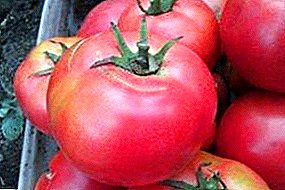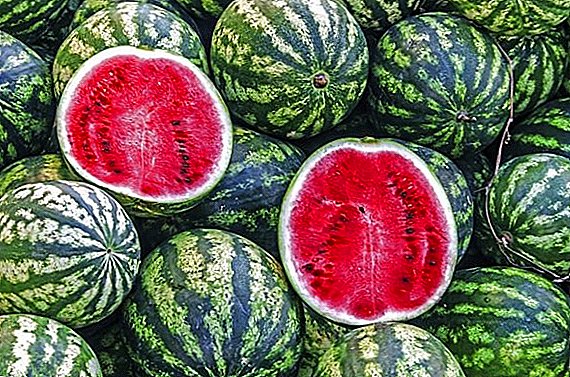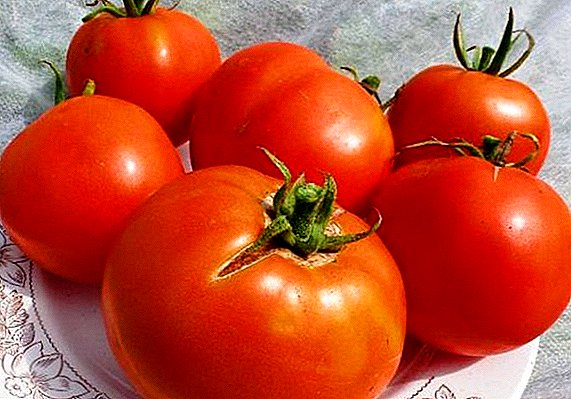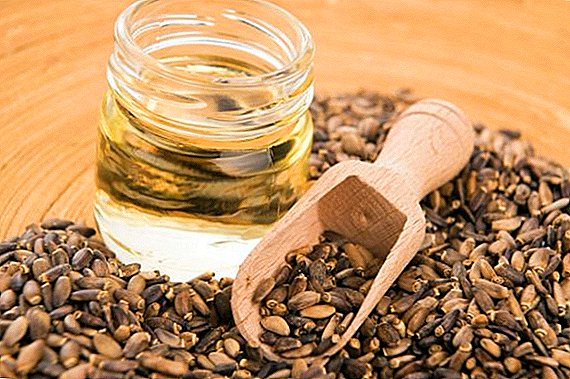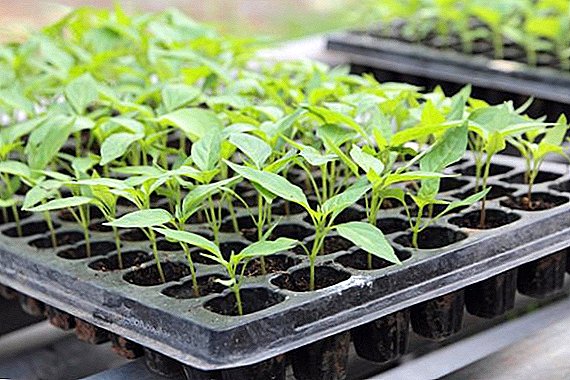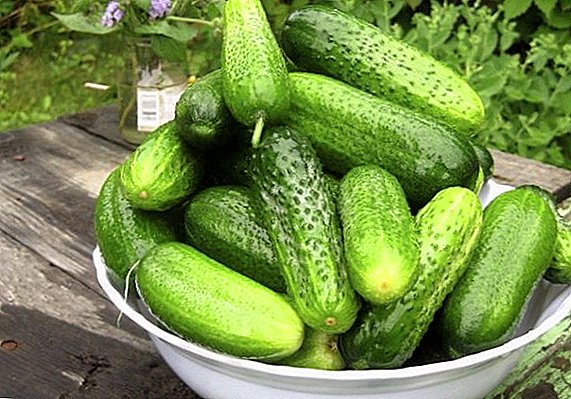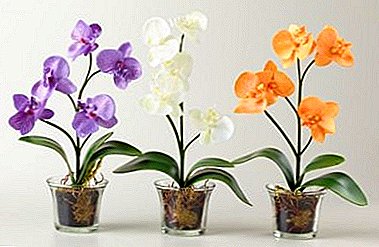 Probably, there is not a single apartment, and certainly not a single house, where there would be no indoor flowers and plants. Many housewives love to decorate their homes representatives of the kingdom of flora, pleasing the eye. And in this article we will talk about how to grow a real pomegranate at home, which will not only be a beautiful addition to your interior, but will also bring undeniable benefits to its original and tart-like fruits.
Probably, there is not a single apartment, and certainly not a single house, where there would be no indoor flowers and plants. Many housewives love to decorate their homes representatives of the kingdom of flora, pleasing the eye. And in this article we will talk about how to grow a real pomegranate at home, which will not only be a beautiful addition to your interior, but will also bring undeniable benefits to its original and tart-like fruits.
Botanical description
In ancient times, the pomegranate plant was widely distributed in the territories of Carthage and the entire northern tip of Africa along the coast of the Mediterranean. Hence the original name "punica" from the Latin word "punicus", which means "Punic", "Carthage." The Russian version of the name went also from the Latin word "granatus", which means "granular".  It is the presence of many grains inside the fruit that characterizes the garnet in the botanical sense. Usually pomegranate fruits are spherical in shape, having a hard peel in the form of a solid shell. Inside is a juicy and tart flesh, formed into hundreds of grains. The color of this shell varies in the range of orange and brown shades, less often you can find a blood-red color.
It is the presence of many grains inside the fruit that characterizes the garnet in the botanical sense. Usually pomegranate fruits are spherical in shape, having a hard peel in the form of a solid shell. Inside is a juicy and tart flesh, formed into hundreds of grains. The color of this shell varies in the range of orange and brown shades, less often you can find a blood-red color.
Did you know? In ancient Greece they believed that pomegranate fruits give immortality, perhaps for this reason in the myths they were often present at the tables of the gods of Olympus.The structure of the fetus is multi-tiered and is divided into several chambers, which, in turn, are divided into nests. All these sectors are separated by thick and rigid walls. Inside each nest, chamber and tier is placed a huge amount of pomegranate grains, which in one copy can be more than a thousand.
 Such massive fruits grow on a rather large tree, which reaches a height of 5-7 meters. The branches of such a tree are distinguished by their subtlety and grace. Pointed foliage with a glossy shiny finish. The flowers of pomegranate are quite large in size, and their color varies in the range of pink-orange and carrot shades.
Such massive fruits grow on a rather large tree, which reaches a height of 5-7 meters. The branches of such a tree are distinguished by their subtlety and grace. Pointed foliage with a glossy shiny finish. The flowers of pomegranate are quite large in size, and their color varies in the range of pink-orange and carrot shades.Important! At home, a pomegranate tree grows to 1.5-2 meters. This is due to the lack of sufficient sunlight and the limited land capacity. In any case, you can not be afraid that the tree will pierce your ceiling.Pomegranate tree is distinguished by its warmth and light-loving. It requires solar energy throughout the year, and in case of its absence such a tree will not bloom and, therefore, will not produce fruits.
Chemical composition
These fruits consist of peel, seeds and pulp. Oddly enough, but each of these elements is useful for the human body. And the calorie content of such a fruit is quite easy, because one average fruit contains only 90 kcal (at the same time 100 grams of pomegranate juice is only 50 kcal).  Pomegranate fruits contain 15 amino acids, including cystine, aspartic acid, hydroxyproline, threonine, histidine, alpha-aminobutyric acid, lysine, glutamic acid, arginine, serine. Most of these compounds are indispensable and are included as an ingredient in the formulas of drugs, the total amount of which in annual production exceeds ten tons.
Pomegranate fruits contain 15 amino acids, including cystine, aspartic acid, hydroxyproline, threonine, histidine, alpha-aminobutyric acid, lysine, glutamic acid, arginine, serine. Most of these compounds are indispensable and are included as an ingredient in the formulas of drugs, the total amount of which in annual production exceeds ten tons.
Find out how pomegranate fruit is useful, how it is used in cooking and medicine.
In addition, the pomegranate contains a real storehouse of vitamins, minerals and nutrients, including:
- vitamin PP - 0.4 mg;
- beta carotene - 0.03 mg;
- vitamin A - 5 mcg;
- Vitamin B1 (thiamine) - 0.04 mg;
- Vitamin B2 (riboflavin) - 0.01 mg;
- vitamin B5 (pantothenic acid) - 0.5 mg;
- Vitamin B6 (pyridoxine) - 0.5 mg;
- Vitamin B9 (folic acid) - 18 µg;
- vitamin C - 4 mg;
- vitamin E - 0.4 mg;
- calcium - 10 mg;
- magnesium - 2 mg;
- sodium, 2 mg;
- potassium 150 mg;
- phosphorus - 8 mg;
- iron - 1 mg.
 And besides all of the above, cellulose is present in the pomegranate composition, which is an indispensable activator of our body's activity and favorably affects the functions of all the internal organs and systems, as well as the complex of vitamins and minerals.
And besides all of the above, cellulose is present in the pomegranate composition, which is an indispensable activator of our body's activity and favorably affects the functions of all the internal organs and systems, as well as the complex of vitamins and minerals.Beneficial features
Together with such a rich composition of vitamins, minerals, amino acids and other beneficial trace elements, the fruits of pomegranate are very useful for the human body. There are five main positive qualities that contribute to the normalization of the work of our body:
- In cases of anemia, pomegranate juice will be a great remedy for treating and correcting the situation. If anemia is detected, a course treatment using pomegranate and pomegranate juice will positively affect and correct the situation. Recommended recipe: Dissolve 200-250 ml of juice in equal proportions with boiled water, take orally one hour before meals. Such a drink is taken three times a day for two months, after which a month break - and then repeat the course.
- It is recommended to leave the skin and membranes between the grains when cleaning the fruit of the pomegranate tree. A decoction of pomegranate "waste" can alleviate pain in cases of indigestion. And from such a decoction you can make compresses for burns - tanning components will help to restore damaged skin. On one cup of boiled water should be diluted 30-35 g of dried skin and bulkheads. Insist, cool, and apply for three days.
- Eating half an pomegranate on an empty stomach will not only enrich your body with valuable elements, but also improve your appetite, increase your hemoglobin level in your blood and normalize your blood pressure. Pomegranate fruit improves the functioning of the heart muscle, accelerates blood regeneration and cleans the blood vessels.
- Stomatitis, sore throat and any other forms of colds safely go into the shadows, giving way to the healing qualities of pomegranate. Freshly and moderately diluted pomegranate juice is used to gargle, while having a disinfectant and antibacterial effect. Juice must be diluted in half with water, because it contributes to the destruction of tooth enamel with its acid. For the same reason, use the juice in its pure form also should not be. It must be diluted with water and consumed through a straw.
- Pomegranate neutralizes free radicals in our body, thereby reducing the risk of oncology. A portion of rich pomegranate grains after the X-ray procedure will not be redundant in order to eliminate the possible consequences of irradiation.

How to grow pomegranate at home
So, there are no doubts that pomegranate is very useful and rich in various mineral compounds and vitamins. Now it's up to sowing and growing such a wonderful plant in your home.
At home, you can grow mango, papaya, pineapple, banana trees and even feijoa.
How to plant pomegranate from the stone
In order to grow a tree from a stone, you will need special seeds collected from the flowers of this plant, since those grains that are in the fruit are no longer usable. It is flowering seeds that are suitable for germination. Having bought such a seed, you need to soak it in a solution of some substance that promotes rapid germination (growth stimulator). For this purpose, suitable, for example, "Kornevin."  In this composition, the seeds should be soaked for a day, after which they can be placed in loose soil under the cover. In this greenhouse the pomegranate will spend some time (2-3 weeks) before sprouts appear.
In this composition, the seeds should be soaked for a day, after which they can be placed in loose soil under the cover. In this greenhouse the pomegranate will spend some time (2-3 weeks) before sprouts appear.
Important! Although the seeds are in a kind of greenhouse, but it also needs to be put in a warm and, most importantly, bright place.During this period, it is important to air and moisten the soil in time so as not to cause premature diseases in a still weak plant. The main feature of this method of cultivation is that the pomegranate tree grown from seeds will bloom only for 5-8 years. If you do not want to wait so long, then in the nurseries you can buy a ready-made young tree.
Pomegranate soil and fertilizer
Despite the fact that pomegranates in the wild grow on rather poor soils in arid areas, in order to create a beautiful tree at home, a more mineralized soil is required. The best option would be to buy soil for roses or begonias. It is rich in useful elements and is well suited for sprouting pomegranate at home. At the bottom of the pot you need to fall asleep a fairly high (about a third of the pot) layer of expanded clay or river pebbles.  If we talk about fertilizers, then it is necessary to apply fertilizer for pomegranate, starting in autumn, when its vegetative period ends, and ending in spring, when the plant needs the maximum amount of additional vitamins and minerals. Feed can be done no more than once every two weeks. Usually, fertilizers are applied once a month to moist soil. The main fertilizers of the spring period are considered nitrogenous, while closer to autumn they are replaced by potassium fertilizers.
If we talk about fertilizers, then it is necessary to apply fertilizer for pomegranate, starting in autumn, when its vegetative period ends, and ending in spring, when the plant needs the maximum amount of additional vitamins and minerals. Feed can be done no more than once every two weeks. Usually, fertilizers are applied once a month to moist soil. The main fertilizers of the spring period are considered nitrogenous, while closer to autumn they are replaced by potassium fertilizers.
Important! The best way to feed fruit-bearing pomegranates is organic, which does not contain nitrates harmful to the human body. At the same time, mineral fertilizers should be used with extreme caution, since, unlike organic fertilizers, they contain a high content of harmful nitrates.Follow all the rules and instructions for use of your chosen fertilizers in order to avoid adverse effects, as it is too bad to overfeed, as well as not to feed.
Moisture and watering pomegranate
Humidity should be maintained at an average, moderate level. In order to humidify the air in the room, you can carry out wet cleaning or put containers with water near the plant. Another way to maintain the level of humidity is to spray the crown of pomegranate with water from a spray bottle and wipe the leaves with a damp, clean cloth.  The main signal for the onset of irrigation time of such a representative fauna is a dried crust of the earth. As soon as you find out that the top layer of the substrate crumbles easily and is completely dry to the touch, feel free to water your pomegranate. It is important not to overdo it with watering, so as not to arouse putrefactive damage to the root system. The approximate frequency of watering - once a week. It will be quite enough to provide your plant with enough moisture.
The main signal for the onset of irrigation time of such a representative fauna is a dried crust of the earth. As soon as you find out that the top layer of the substrate crumbles easily and is completely dry to the touch, feel free to water your pomegranate. It is important not to overdo it with watering, so as not to arouse putrefactive damage to the root system. The approximate frequency of watering - once a week. It will be quite enough to provide your plant with enough moisture.
Important! During the flowering period, the amount of watering is better to be halved. Spring should increase the abundance of watering: this mode must be maintained from February to May, until the pomegranate blooms.
Lighting conditions
Good and properly chosen lighting will guarantee good flowering and fruiting. Since pomegranate is a heat-loving and light-loving representative of the fauna, it needs to create optimal conditions under which the light day should not be less than 12 hours. A pot of pomegranate can be put on the windowsill (any suitable, except for the north). But there is a nuance here, because it must be protected from direct midday sunlight. For this purpose, you can help blinds or ordinary curtains.  In the summer, for example, such a seedling can be planted in the garden at the cottage, if any. Pomegranate perfectly adapts to natural conditions. But in the winter and a lingering cloudy autumn, such a plant will require additional lighting, which you can provide using an ordinary fluorescent lamp or a special fitolamp. Both ways of additional illumination will give your plant what it needs - the correct twelve-hour lighting mode.
In the summer, for example, such a seedling can be planted in the garden at the cottage, if any. Pomegranate perfectly adapts to natural conditions. But in the winter and a lingering cloudy autumn, such a plant will require additional lighting, which you can provide using an ordinary fluorescent lamp or a special fitolamp. Both ways of additional illumination will give your plant what it needs - the correct twelve-hour lighting mode.
Many of us are accustomed to the traditional fruit at the dinner table - apples, pears. However, exotic specimens contain no less benefit. Find out what vitamins and minerals are rich in lychee, papaya, longan, kivano, feijoa.
Pomegranate Transplant
Pomegranate transplant at home is also a separate ritual with its own nuances. Firstly, it is better not to touch or replant the plant for up to three years, since the root system and the young stem are not yet ready for mechanical stress, and such a procedure can only harm.
Secondly, expanding the living space for a flower after three years costs gradually, each time choosing a new pot 3–4 cm wider than the previous one.
Important! It turns out that pomegranate loves crampedness. When the roots of this plant run into the walls of the pot, feeling stiff, such a pomegranate will bloom more abundantly and will yield greater yield.
Thirdly, the best time for transplantation is considered to be early spring, before the moment of sap flow and flowering. When transplanting, the grenades are taken out with a clod of earth from an old pot and placed in a new one, in which the substrate was previously laid and fresh earth was added. The space around the earthen coma and roots is also filled with new earth, slightly tapping the container to evenly fill the voids.  At about the sixth year, your grenade will become an adult and he will not need further transplantation. As a rule, for an average pomegranate tree a capacity of up to 5 liters is required. And the depth is not as important as the width of the tableware, because the root system of pomegranates spread to the sides.
At about the sixth year, your grenade will become an adult and he will not need further transplantation. As a rule, for an average pomegranate tree a capacity of up to 5 liters is required. And the depth is not as important as the width of the tableware, because the root system of pomegranates spread to the sides.
Pomegranate Trimming
For each plant pruning is a positive point, contributing to the strengthening and healing. This procedure brings the crown to the proper and well-groomed appearance, giving the houseplant the necessary ergonomics and accuracy. In addition to a purely visual effect, such manipulations reduce the load on the plant, since unnecessary shoots are removed that require constant replenishment. And after removing unnecessary shoots, the pomegranate tree can direct all its strength to the cultivation of large and fleshy fruits.
So, pomegranate should be cut three times per season.
The first pruning: held in March, before the start of the vegetative period. It is worth removing all the branches growing inside, as well as small branches that only hinder the development of the main shoots. Up to 6 main branches can be left on one trunk, and it is better to remove all other shoots. On each of such main branches, 3-5 branches of the second line are left, and on them, respectively, 3-5 branches of the third order. Such a crown will look neat and symmetrical. The second pruning: held in summer, during the flowering and ripening of fruits. Do not worry, such pruning will only help your pet to save all the forces for better maturation, because it does not have to spend extra energy on new shoots. In this approach, it is worth removing the newly formed shoots and dry branches.
Third pruning: held in the fall, after harvest. All excess small shoots and branches directed inside the crown should be removed, as well as dried or fading branches.
Important! Only those branches that have grown this season bear fruit. Once harvested from the shoots of this year, you can prune a branch at level 5 of the bud to begin dividing into the next row of branches that will bear fruit next year.
Propagation of the room grenade
There are several types of propagation of pomegranate, including: planting seeds, growing from cuttings or grafting method. How to grow a pomegranate, so to speak, from scratch (from seeds) you already know, and then we will talk about two other methods.
Pomegranate from cuttings
This method allows you to save the main features of the selected type without loss. The best time for cutting and sprouting cuttings will be summer. Choose still ligneous shoots with 4-5 buds and a length of about 12-15 centimeters. Having removed the two lower buds, stick the cuttings (it is better to prepare several of them at once, since some may not be taken and die) at an angle of 30-45 degrees to the previously prepared soil.  With regular spraying, watering and proper care, the finished seedling will be formed in about 2-3 months. After that, it can be transplanted into a separate pot. Such a pomegranate will bloom next year, but it will be able to bear fruit only after several seasons.
With regular spraying, watering and proper care, the finished seedling will be formed in about 2-3 months. After that, it can be transplanted into a separate pot. Such a pomegranate will bloom next year, but it will be able to bear fruit only after several seasons.
How to plant a pomegranate
Grafting a pomegranate will be quite a laborious process, since not every beginner grower will be able to carry out this operation correctly. On a stalk grown with grain, a healthy fruit-bearing plant is grafted. Such a vaccination can be carried out by various methods, the most popular of which are: simple copulation, behind the cortex, in cleft, in the butt and in the lateral cut. Each of these methods is different in its nuances and difficulties, and therefore, if you are afraid that you can not cope, better seek the services of a professional or resort to a different method. In the case of a successful graft, the plant will bloom only a few years later, and it will bear fruit in about 4-7 years.
Pests and possible diseases
Like all home plants, a pomegranate tree can also be susceptible to various diseases. This is due to all sorts of insects, including powdery worms, mites, scale insects, aphids, moths, and whiteflies. Such parasites can cause root cancer, Phomopsis, or branch cancer, gray rot and leaf spot.Let's see how to counter such pests, and how to protect your plant from them for a long time.
 Aphid. 40-45 grams of tobacco in 1 liter of water of two-day exposure will cope with the aphids.
Aphid. 40-45 grams of tobacco in 1 liter of water of two-day exposure will cope with the aphids.
Before use, you can add another liter of water to this solution so that it is not so concentrated, as well as to mix grated laundry soap. Spraying the plant out of the sprayer will cope with the plant lice.
We advise you to learn how to deal with aphids popular methods.
Shchitovka, mites and whitefly. A five-day infusion of onion and garlic peel per liter of water allows you to quickly and efficiently cope with these pests.
Small moth. From this parasite, only the manual method of collecting the affected pomegranates will help: remove the fallen in time and remove the already infected fruit from the tree.
Mealy worms. Help chemicals that need to spray the pomegranate tree. Triple processing with an interval of one week will help to defeat the parasites. 
You can use "Confidor", "Mospilan" or "Aktar", and from spider mites - Acartell or Fitoverm acaricides.
Cancer Diseases Cancer of the roots, stem or branches is a fairly common disease of home pomegranate trees. They appear as a result of mechanical damage, after the application of which the crust begins to crack and turn black, and characteristic dark tumors appear on the surface.
These diseases can be defeated if the affected areas are cleaned up to healthy wood, then treated generously with copper sulphate solution, and then the affected area is sealed with garden pitch. In most cases, this procedure should help. If we are talking about an extensive defeat, then it makes sense to cut the tree under the stump. Perhaps it will be saved and in time it will launch new shoots, but if not, then such a fate would have waited for him anyway, given the abundance of cancers.
Did you know? The mention of the fruits of the pomegranate tree is in the Quran. The first is that the pomegranate tree grew in paradise. The second is that the Prophet Mohammed advised his followers to use the fruits of pomegranates as a means against envy and hatred.
In addition to these diseases, there may be a number of other symptoms indicating a lack of care for pomegranate. These include the yellowing of leaves, their falling off, or even the desiccation of a tree altogether. To cope with such manifestations can be quite easy if you follow the recommendations:
Yellowing leaves. Such a disease is associated with too high a temperature in the room (of course, if one of the above-described pests has not been identified). If dark leaves appeared on the leaves, except for yellowness, the reason is lack of moisture: it is worth watering your plant as soon as possible. The basic rule of watering and maintaining the desired level of moisture in the flower tank is the degree of dryness of the soil. So, if you find that the soil is easily loosened and it is not moist to the touch, it is worth watering such a substrate. The normal irrigation regime for an average pomegranate tree is once a week.
The basic rule of watering and maintaining the desired level of moisture in the flower tank is the degree of dryness of the soil. So, if you find that the soil is easily loosened and it is not moist to the touch, it is worth watering such a substrate. The normal irrigation regime for an average pomegranate tree is once a week.
Did you know? According to one version of the Biblical tradition, it was a pomegranate, and not an apple of snakes, that seduced Eve in Paradise.Falling leaves. This is an advanced stage of yellowing. If you intervened at the wrong time in the process of healing your tree, then the falling of the leaves will become its natural continuation. It is necessary to immediately remove pests (if they are found) or correct the care of the plant, watering it or lowering the temperature in the room (for example, ventilating the room). In addition to painful manifestations, leaf fall can be caused by the end of the vegetative period, that is, by preparing the pomegranate tree for wintering. Thus, leaf abscission can be both a signal of malfunctions and a natural phenomenon, which you should not fear.
Shrinking leaves. Such a disease suggests that in the room where the pomegranate tree is located, the humidity is not high enough and it is necessary to spray the plant with plain water. Another variant of this disease is damage to the root system and problems with it. Such damage may result from improper, excessive watering. If the soil smells like mold and dampness, then you need to transplant the tree into another container as soon as possible and replace the substrate. Before this, carefully inspect the roots for putrefaction and, if necessary, remove the rotting. Wounds from cuts should be covered with crushed coal.
Recommendations
 In the maintenance and safe cultivation of pomegranate at home should follow strict rules of care. Keep track of all the slightest manifestations of diseases in your plant and adjust the conditions of its content. Maintain a balance in temperature, do not forget to ventilate the room if it becomes too hot, or do wet cleaning and additional room moisture to maintain a climate close to the Mediterranean.
In the maintenance and safe cultivation of pomegranate at home should follow strict rules of care. Keep track of all the slightest manifestations of diseases in your plant and adjust the conditions of its content. Maintain a balance in temperature, do not forget to ventilate the room if it becomes too hot, or do wet cleaning and additional room moisture to maintain a climate close to the Mediterranean.
Also, wiping the leaves with a damp and clean cloth will also have a beneficial effect on the health of the plant. In the cold season, when the heating season has not yet begun, and it is very cold in the apartment, you should acquire a heating device, so that not only your plant, but also you will be comfortable.
It is also important to water the grenades in time to prevent the soil from drying out, but do not overdo it with such a procedure so as not to start the putrefactive processes in the root system.
Did you know? During the autopsy of the Egyptian pyramids, it was discovered that a grenade was laid in the sarcophagus to the departed rulers. This fruit was considered sacred and able to give a new life. And the pomegranate tree was called the "tree of life."
Periodically spray pomegranate leaves with plain water to create the effect of natural rain and maintain a normal moisture balance, because grenades grow near the Mediterranean Sea, where the climate is very humid and hot.  It is necessary to periodically feed various mineral fertilizers as a preventive measure against the onset and development of undesirable diseases. Such procedures can be carried out before the beginning of the vegetative period in the spring and after its completion at the end of autumn. The interval for dressings can vary from two weeks to a month. More frequent fertilization is fraught with irreversible effects of disease.
It is necessary to periodically feed various mineral fertilizers as a preventive measure against the onset and development of undesirable diseases. Such procedures can be carried out before the beginning of the vegetative period in the spring and after its completion at the end of autumn. The interval for dressings can vary from two weeks to a month. More frequent fertilization is fraught with irreversible effects of disease.
A bright green flowering plant with pointed shiny leaves, which is pomegranate, will be an excellent decoration for any home. Its ergonomic crown will delight you with its grace, and tasty fruits will benefit your body, becoming an interesting and original addition to various dishes or by themselves. Guided by the rules of care and recommendations for the content, you can turn the process of growing pomegranate tree at home into a real pleasure. Surround the pomegranate with attention, care and proper care, and it will not remain in your debt and will long delight your lush crown and bright, tasty and healthy fruits.


